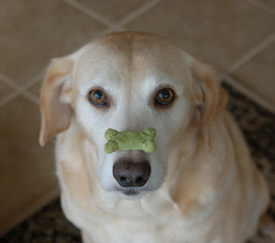"Never ever" to "happily ever after"
There is a popular term used on the Yahoo Training Levels group: "never ever" behaviors. This refers to seemingly impossible behaviors that the trainer thinks will "never ever" be trained. The funny thing is, they almost always end up being achieved!
Group members have been conditioned to view "never ever" behaviors as "distinct possibilities." Given enough thought, creativity, time, and, of course, clicker training, the "never ever" behavior becomes a "must do" challenge.
Common dilemmas

Some "never ever" behaviors that come to mind:
- hot dog retrieve
- training confirmed bike chasers to come to heel when they see a bike
- loose-leash walking with very determined pullers
- self-control around sheep/other dogs/[insert thing that makes dog crazy here]
- recall away from thrown tennis ball/live rabbit/[insert thing that dog wants to chase here]
- previously very excited dog being quiet and calm while other dog runs agility course
Convince yourself
So how do these "never ever" behaviors become an achievable reality? Obviously, they aren't really "never ever" behaviors or they would "never ever" have been achieved. They were only "never ever" thoughts in the trainer's mind. Getting the behavior is usually the easy bit; convincing the trainers that they can do it is the hard part.
With the tools and technology we have at our disposal (i.e., clicker training), we can train almost any behavior. Unfortunately, what can happen is that frustration, prior learning, self-doubt, or fear can set in and make these possibilities seem less achievable than they really are.
Gather your tools, lists, ideas, and friends
A good place to start is by forgetting about all the problems, obstacles, past failures, doubts, or beliefs you might be hanging on to, and define exactly the behavior you would like to see. Then break it down into components—write them down. Break those components down into tiny little chunks and write them down, too.
Now get creative, or ask some friends to be creative for you, and list some ideas for training these components. Think about tools or props that might help you. Think about whether it would be easier to train this behavior forward or backward. (Some behaviors are easier to backwards-chain.)
If you are trying to stop an unwanted behavior, use the above exercise to develop a behavior you want to see instead of the unwanted behavior, but also think about what might be reinforcing the unwanted behavior. Figure out how to prevent reinforcement of the unwanted behavior, or use that reinforcement to reinforce the preferred behavior instead.
One step at a time
Then, assemble your tools or props, your training plan, and aim to get the first little chunk trained. Don't worry about the long road ahead; it might not be as long as you think. Train the first little chunk of behavior so that you get it 80% of the time, then work on the next chunk. Don't worry about cues, or distractions, or proofing, or any of those things. Just focus on the basics—criteria, timing, and rate of reinforcement.
You might never say "never ever" ever again!



Post new comment